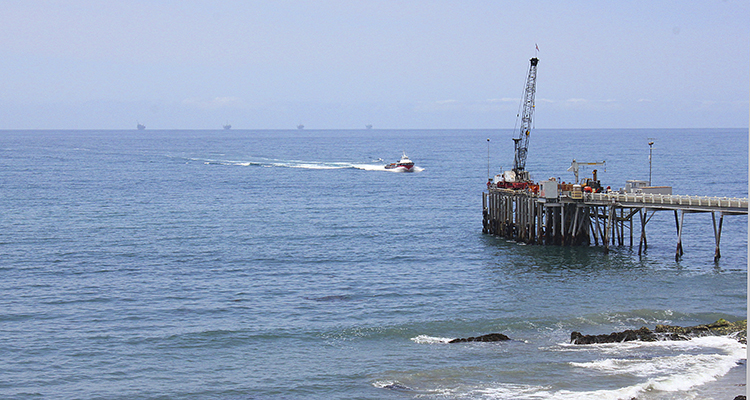Trump’s offshore drilling plan met with hostility and support
This May 16, 2015 photo shows oil drillings offshore of a service pier in the Santa Barbara Channel off the coast of Southern California near Carpinteria. The surface temperature of the North Atlantic Ocean are climbing at unprecedented rates. (AP Photo/John Antczak)
January 18, 2018
When President Trump ran his 2016 presidential campaign, he made expanding energy exploration and offshore drilling a key aspect of his platform. Now, he is making moves to fulfill that promise.
The Trump administration recently announced a five-year plan to widely open offshore drilling from the Atlantic to Pacific to Arctic oceans. According to the Associated Press, this would increase nearly the entire scope of the Gulf of Mexico for drilling, as well as parts of California that have been closed since 1984.
The administration also provided action points to cut regulations on offshore drilling. The initiatives taken by President Trump on energy exploration represent a stark contrast from his predecessor, former President Barack Obama. Obama previously tightened regulations to watch offshore drilling more closely after the 2010 BP oil spill crisis in the Gulf.
The Obama-era regulations provided for increased monitoring of ocean floor wells. The Trump administration looks at rolling back regulations as a strong way to advance energy independence. U.S. Interior Secretary Ryan Zinke told press members that it portrays “a clear difference between energy weakness and energy dominance.”
The environmental community largely opposes the plan, as they have long stood against oil drilling for its effects on the environment, the scenery of the coasts and fishing life.
Notable public officials oppose the plan as well. This includes Florida Gov. Rick Scott, who voiced environmental concerns. Following his dissent, the Trump Administration announced on Jan.10 that they are no longer planning to drill for oil off the Florida coast, which removes parts of the eastern Gulf of Mexico from the plan.
In Louisiana, there is a significant amount of support from high-ranking key figures. The expansion of oil and gas production for them signals job creation in the state.
Louisiana House Majority Whip Steve Scalise said in a statement, “My constituents in southeast Louisiana whose jobs depend on the energy industry can rest easy knowing that oil and gas development is a priority for this administration,”
Louisiana Sen. Bill Cassidy similarly declared his unwavering support. In a speech on the Senate floor on Jan. 4, he sent his opposing Democratic colleagues a reminder that “oil and gas manufacturers have co-existed with other activities for decades.”
Geologist Jim Zotkeiwicz of Cox Operating, a New Orleans oil and gas company, said that there is significant potential for new jobs to be brought to the state through the plan.
“We have a strong history of having great service companies in Louisiana,” Zotkeiwicz said. “Many new jobs could be supplied to rig workers, mud loggers and specialized people that operate platforms and rigs.”
The administration wants public discourse to play out until they decide how to finalize the plan, which is still a draft.








